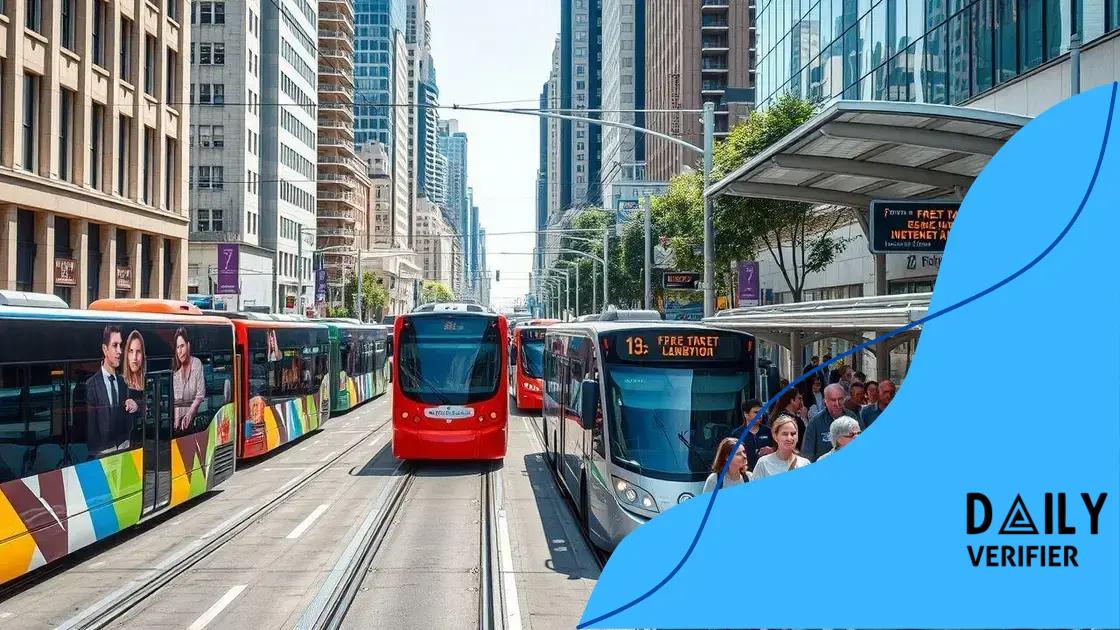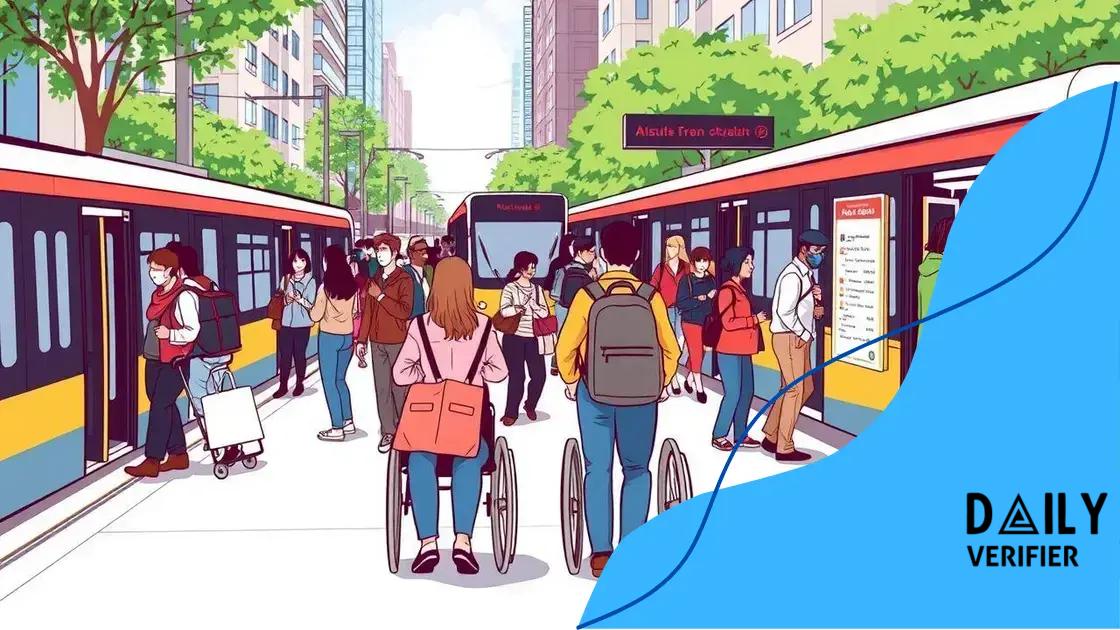Public transport reform hits ballot in major cities

Public transport reform hits ballot significantly impacts urban mobility by improving accessibility, reducing commute times, and fostering economic growth, while failures lead to ongoing dissatisfaction and stagnation.
Public transport reform hits ballot as cities grapple with aging infrastructure and increased demand. Residents are eager to know how these changes could affect their daily commute and the overall urban experience.
Understanding the need for public transport reform
As cities expand and populations grow, the need for public transport reform has become increasingly clear. With more people relying on public transit, it’s essential to ensure that systems are efficient, reliable, and accessible.
Many urban areas face challenges such as overcrowding, outdated infrastructure, and insufficient funding. This creates a pressing need for change. Understanding what drives these reforms can help residents engage in the conversation and advocate for better transportation options.
The Impact of Growth on Transit Systems
Population growth in many cities has outpaced the development of public transport systems. As a result, commuters often experience long wait times and crowded vehicles. This can lead to frustration and decreased usage of public transport. Addressing these issues is crucial for encouraging more people to use public transport.
Key Benefits of Reform
Reforming public transport systems can lead to various benefits:
- Increased accessibility for all residents.
- Improved efficiency in travel times.
- Enhanced safety and reliability.
Moreover, efficient public transport can reduce traffic congestion and lower carbon emissions, which is vital for environmental sustainability.
Finally, engaging the community in discussions about these reforms can foster support and lead to better solutions that fit the needs of all users. Collaboration between local governments and citizens ensures that proposed changes are grounded in real-world requirements.
Key features of proposed reforms
The key features of proposed public transport reforms are designed to enhance urban mobility and improve commuter experiences. These features aim to address the pressing issues faced by many transit systems today.
Enhanced Accessibility
One major reform is focusing on making public transport more accessible to everyone, including the elderly and those with disabilities. By updating facilities and services, cities can ensure that all residents can use public transit without obstacles.
Investment in Infrastructure
Another vital aspect of the proposed reforms is investing in modern infrastructure. This includes:
- Upgrading aging vehicles and maintaining them properly.
- Implementing smart technology for real-time tracking of buses and trains.
- Incorporating dedicated lanes for buses to improve travel speed.
Such investments not only improve service but also reduce operational costs in the long term.
Focus on Sustainability
With growing concerns about climate change, sustainability is a top priority in public transport reform. Cities are exploring the use of clean energy options, such as electric buses, to reduce their carbon footprint. This shift can significantly benefit the environment and public health.
In addition to environmental measures, the reforms seek to develop integrated transport systems that connect various modes of transport, making it easier for users to switch between cars, bikes, and public transit.
By understanding these key features, communities can better engage in discussions about the reforms and advocate for solutions that meet their needs.
How reforms impact commuters and communities

Understanding how reforms impact commuters and their communities is essential for grasping the broader implications of public transport changes. These reforms can lead to significant improvements in daily life for residents.
Benefits for Commuters
One of the most immediate effects of public transport reform is an enhanced commuting experience. With improved reliability and more frequent service, commuters can spend less time waiting for transit. This efficiency means more time to focus on work, family, or leisure activities.
Community Connectivity
Moreover, effective reforms can strengthen connections between neighborhoods. By improving routes and schedules, residents gain easier access to essential services and job opportunities. This access plays a crucial role in fostering community engagement.
Reforms also encourage social interactions, as people can more easily meet friends or visit local businesses. When public transport is reliable, it nurtures a sense of community and belonging.
Economic Impact
When public transport systems improve, the local economy often benefits as well. With better transit, businesses attract more customers, creating jobs and boosting the economy. Public transport reform can stimulate investments in surrounding areas, enhancing property values.
- Increased foot traffic for local shops and services.
- New jobs created through improved infrastructure.
- Enhanced property values leading to higher taxes for local projects.
Overall, these impacts highlight the vital role public transport reforms play in shaping vibrant, connected communities where residents can thrive.
Challenges faced in implementing changes
Implementing public transport reforms is not without its challenges. Understanding these obstacles is crucial for creating effective solutions that enhance urban travel.
Funding Issues
One of the primary challenges is securing adequate funding. Public transport projects often require significant investment. Budget constraints can limit the scope of reforms, impacting their effectiveness.
Community Resistance
Another challenge is community resistance to change. Some residents may feel uncertain about new routes or service changes. This resistance can be due to fears about increased traffic, noise, or job losses in related sectors.
To address these concerns, cities must engage the community in the planning process. Open discussions and public forums allow residents to express their opinions and contribute ideas, which can ease apprehensions.
Infrastructure Limitations
Many cities also face outdated infrastructure that can hinder the implementation of reforms. Upgrading tracks, signals, and stations takes time and resources. Sometimes, construction delays can prevent timely improvements.
Additionally, coordination with various agencies and stakeholders is essential but can complicate processes. Building the necessary partnerships takes effort and patience.
- Collaboration between city planners and transport authorities is crucial.
- Stakeholder engagement is vital for successful project implementation.
- Balancing different community needs and expectations can be challenging.
Addressing these challenges requires effective planning, communication, and community involvement, ensuring public transport reforms can truly benefit all residents.
What happens if reforms pass or fail?
The outcome of public transport reforms can significantly affect communities. Understanding what happens if these reforms pass or fail helps residents prepare and respond to potential changes in urban mobility.
If Reforms Pass
If public transport reforms are successful, numerous benefits emerge. Cities may experience improved transit systems that offer increased reliability, shorter wait times, and enhanced accessibility for all users. With better service, more people might choose to use public transport, leading to reduced traffic congestion and lower emissions.
Economic Growth
Successful reforms can also stimulate economic growth. Local businesses often thrive as public transport attracts more customers. Additionally, improved connectivity can lead to job creation and increased property values near transit hubs.
Moreover, the community will likely enjoy better quality of life, with more accessible options for education, healthcare, and recreation. An engaged and informed public may foster ongoing support for future initiatives.
If Reforms Fail
On the other hand, if reforms fail, the status quo persists, leading to continued frustration among commuters. Insufficient funding and lack of improvements may further deter the use of public transport, causing travel times to increase.
Neglected infrastructure may lead to additional safety concerns, limiting access to essential services and opportunities for many residents. A failure to reform can result in a sense of disconnection, where communities become less accessible and engaged.
- Stagnation in local economic development due to lack of investment.
- Increased public dissatisfaction can lead to protests or calls for new plans.
- Potential loss of funding and support for future transport initiatives.
Understanding these possibilities allows communities to advocate more effectively for positive change, ensuring that their voices are heard in the reform process.
FAQ – Frequently Asked Questions about Public Transport Reform
What are the main benefits of public transport reforms?
Public transport reforms can lead to improved accessibility, reduced commute times, and enhanced economic opportunities for communities.
How can community engagement impact the success of transport reforms?
Community engagement ensures that the needs and concerns of residents are considered, increasing the chances of successful implementation and public support.
What challenges do cities face in implementing public transport reforms?
Common challenges include securing funding, overcoming community resistance, and upgrading outdated infrastructure.
What happens if public transport reforms are unsuccessful?
If reforms fail, it can result in ongoing commuter dissatisfaction, limited access to services, and a stagnation of economic growth in the area.






